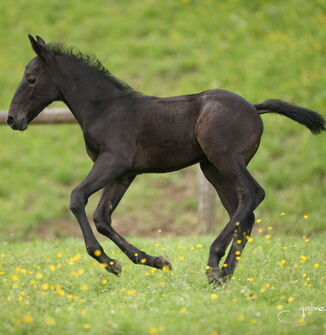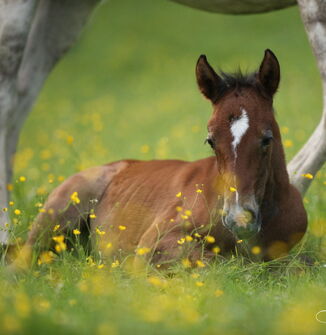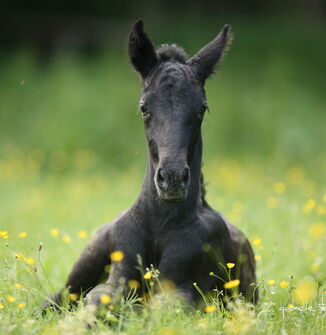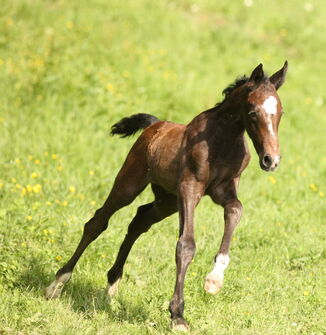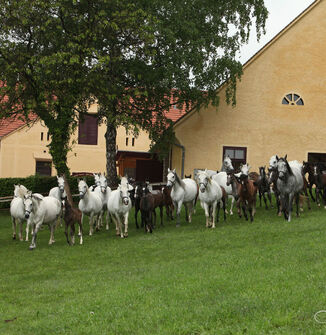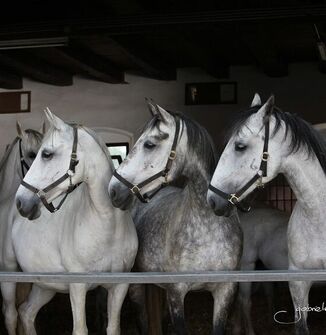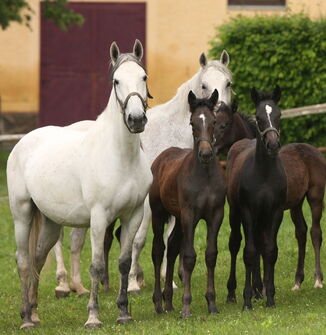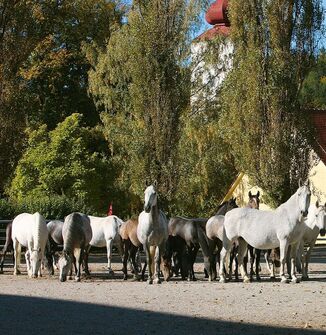The Lipizzaner breeding: national, intangible cultural heritage
With the Lipizzaner breeding in Piber, we not only ensure the continued existence of the Lipizzaner stallions of the Spanish Riding School, but also contribute to the preservation of the oldest cultural horse breed in Europe. In 2016, the knowledge regarding this responsible task was finally declared a national, intangible cultural heritage by UNESCO.
Today's Lipizzaner breeding at the stud in Piber goes back to the six stallion lines and 17 classic mare families of the Lipizzaners that already existed in the 18th century.
At that time, the "Lipizzaners" were still motley: bay, chestnut, dun, isabelle, plate, tiger pinto or black - but not a single one was white at that time. The white colour, the mould colour, only became established towards the end of the 18th century / in the 19th century and has remained until today. This colour was preferred for breeding reasons of taste. In addition, the white hair of the Arabian has proven to be dominant hereditarily, so that today only in very rare cases the dark (mainly brown) coat is preserved. However, it is part of the tradition of the Spanish Riding School Vienna that there is always at least one brown Lipizzaner in the stables of the riding school. They are considered lucky charms.
Lipizzaners are characterised by a perfect, nobly formed physique, graceful movements, eagerness to learn, liveliness, good nature, courage, hardness and endurance. The well-shaped head of the Lipizzaner can sometimes have a ram nose. The neck is set a little higher and is carried nobly. The strong, muscular back ends in a very strong croup. The appearance corresponds to that of the baroque show and parade horse, although the frame is more like a rectangle. The well set tail is dense and of fine hair. The limbs dry and profiled, have clean hocks and beautifully formed hooves.
The lines of stallions
There are 8 stallion lines worldwide. We in Piber breet with 6 lines:
Pluto (white horse), born 1765
of pure Spanisch ancestry,
from the royal Danish court stud farm Frederiksborg
Conversano (black), born 1767
original Neapolitano
Neapolitano (brown), born 1790
Neapolitano from Polesina
Favory (dun), born 1779
from the court stud farm in Kladrub
Maestoso (white horse), born 1773
from the court stud farm in Kladrub
Siglavy (white horse), born 1810
original Arabic horse, imported from Syria
by Prince Schwarzenberg
The stud families
The Lipizzaner Stud Piber breeds with all 17 classical mare families. This makes the Lipizzaner Stud Piber the only stud in the world that holds mares from all classic Lipizzaner mare families. The ancestral dams of these mare families were born in the 18th century and formed the basis of the imperial stud. Their descendants can be traced back seamlessly to the respective family founder.
Sardinia Sardinia. Lipizza 1776
Spadiglia Spadiglia, Lipizza 1778
Argentina Argentina, Lipizza 1767
Africa Africa, Kladrub 1747
Almerina Almerina, Kladrub 1769
Presciana - Bradamente Presc./Bradm., Kladrub 1782/1777
Englanderia Englanderia, Kladrub 1773
Europa Europa, Kladrub 1774
Stornella - Fistula Fistula, Koptschan 1771
Ivanka - Famosa Ivanka, Koptschan 1754
Deflorata Deflorata, Fredriksborg 1767
Capriola Capriola, Kladrub 1785
Rava Rava, Kladrub 1755
Gidrane Gidrane, 1841
Djebrin Generale Junior, Babolna 1824
Mercurio Freies Gestüt, Radautz 1806
Theodorosta Theodorosta, Bukovina 1870
The characteristics of a Lipizzaner
Hight
153 to 158 cm
Appearence
noble, with a classy expression and rectangular to square frame
Head
light ram's head or slightly arabicised head with convex nose line, strong cheek pouches and large, black eyes
Presentation
medium height, athletic, elegant
Body type
muscular hindquarters, sloping pasterns, medium length and strong back
Movements
graceful, bouncy gait, high knee action
Coat
more than 90% are white horses
Interieur
persistent, undemanding, temperamental, tough, highly sensitive, intelligent, people-oriented, sociable, good-natured, obedient, docile and willing to perform
Development
Late maturing, above average longevity, suitable for breeding and work under saddle until old age
